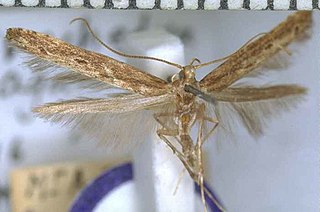
Parcoblatta fulvescens, the fulvous wood cockroach, is a species of cockroach endemic to the United States and possibly Canada that measures around 13 mm (0.5 in) long.

Campaea perlata, the pale beauty, also known as the fringed looper (caterpillar), is a species of moth in the family Geometridae, known as geometer moths, found in North America. Some sources also name it the light emerald, though this may be confused with the related European moth Campaea margaritata. It is common throughout its range.

Aglossa cuprina, the grease moth, is a snout moth, family Pyralidae, described by Philipp Christoph Zeller in 1872. The grease moth is closely related to the genus Pyralis, and as a result, is usually associated with the meal moth, Pyralis farinalis.

Chytolita is a monotypic litter moth genus of the family Erebidae erected by Augustus Radcliffe Grote in 1873. Its only species, Chytolita morbidalis, the morbid owlet moth or morbid owlet, was first described by Achille Guenée in 1854. It is found in large parts of North America, from coast to coast in the north and south to North Carolina, Texas and Florida in the west. The habitat consists of deciduous woods and edges.

Batrachedra agaura is a species of moth in the family Batrachedridae. It is endemic to New Zealand. This species is distributed throughout the country. The species inhabits native forests, especially beech and kanuka forests or manuka scrubland. The larvae of this species are associated with sooty mold and sooty beech scale. It has been hypothesized that the larvae feed on sooty beech scale. However, they may also feed on the sooty mold itself. The adult female is lighter in appearance than the male, and the species shows considerable variation in patterns on the forewing. Adults are on the wing from October to February. They are nocturnal and occasionally attracted to light.
Hellinsia chlorias, the chlorias plume moth, is a moth of the family Pterophoridae. It is found in the United States, including Mississippi, New York, Colorado and Kentucky.
Ethmia submissa is a moth in the family Depressariidae. It is found in Cuba, Jamaica and Puerto Rico. It has also been recorded from southern Florida in the United States.
Holcocera iceryaeella is a moth in the family Blastobasidae. It is found in California, United States.
Usingeriessa brunnildalis is a moth in the family Crambidae. It was described by Harrison Gray Dyar Jr. in 1906. It has been recorded in the US states of California and Texas.

Pyrausta morenalis is a moth in the family Crambidae. It was described by Harrison Gray Dyar Jr. in 1908. It is found in North America, where it has been recorded from Washington to California and west to Texas and Nevada. It is also found in Mexico.
Eudonia expallidalis is a moth in the family Crambidae. It was described by Harrison Gray Dyar Jr. in 1906. It is found in North America, where it has been recorded from Washington to Nevada and California.
Scoparia cinereomedia is a moth in the family Crambidae. It was described by Harrison Gray Dyar Jr. in 1904. It is found in North America, where it has been recorded from British Columbia, Kentucky, Maine, Manitoba, Maryland, New Brunswick, New Hampshire, North Carolina, Nova Scotia, Ohio, Ontario, Quebec, South Carolina, Tennessee, Virginia and West Virginia.
Scoparia penumbralis, the dark-brown scoparia moth, is a moth in the family Crambidae. It was described by Harrison Gray Dyar Jr. in 1906. It is found in North America, where it has been recorded from Alabama, Maine, Maryland, Massachusetts, Michigan, Minnesota, Newfoundland, North Carolina, Nova Scotia, Ohio, Ontario, Quebec, South Carolina, Tennessee, West Virginia and Wisconsin.

Dichomeris punctidiscellus, the spotted dichomeris moth, is a moth in the family Gelechiidae. It was described by James Brackenridge Clemens in 1863. It is found in North America, where it has been recorded from southern Quebec, southern Ontario and Nebraska to Florida and south-eastern Texas.
Theisoa pallidochrella is a moth of the family Gelechiidae. It was described by Vactor Tousey Chambers in 1873. It is found in North America, where it has been recorded from Kentucky and Illinois.
Chrysoesthia versicolorella is a moth of the family Gelechiidae. It was described by William D. Kearfott in 1908. It is found in North America, where it has been recorded from California.
Polyhymno acaciella is a moth of the family Gelechiidae. It was described by August Busck in 1900. It is found in North America, where it has been recorded from Oklahoma, Texas, Arizona and California.
Taygete gallaegenitella is a moth in the family Autostichidae. It was described by James Brackenridge Clemens in 1864. It is found in the United States, where it has been recorded from New York to Florida and to Texas.
Meganola varia is a species of moth in the family Nolidae and superfamily Noctuoidea.
Lacosoma arizonicum, the southwestern sack-bearer moth, is a species of moth in the family Mimallonidae and one of four species of sack-bearers occurring north of Mexico. Its type locality is the Chiricahua Mountains of Arizona. The species was first described by Harrison Gray Dyar Jr. in 1898 from a single male specimen and has Hodges number 7660.






